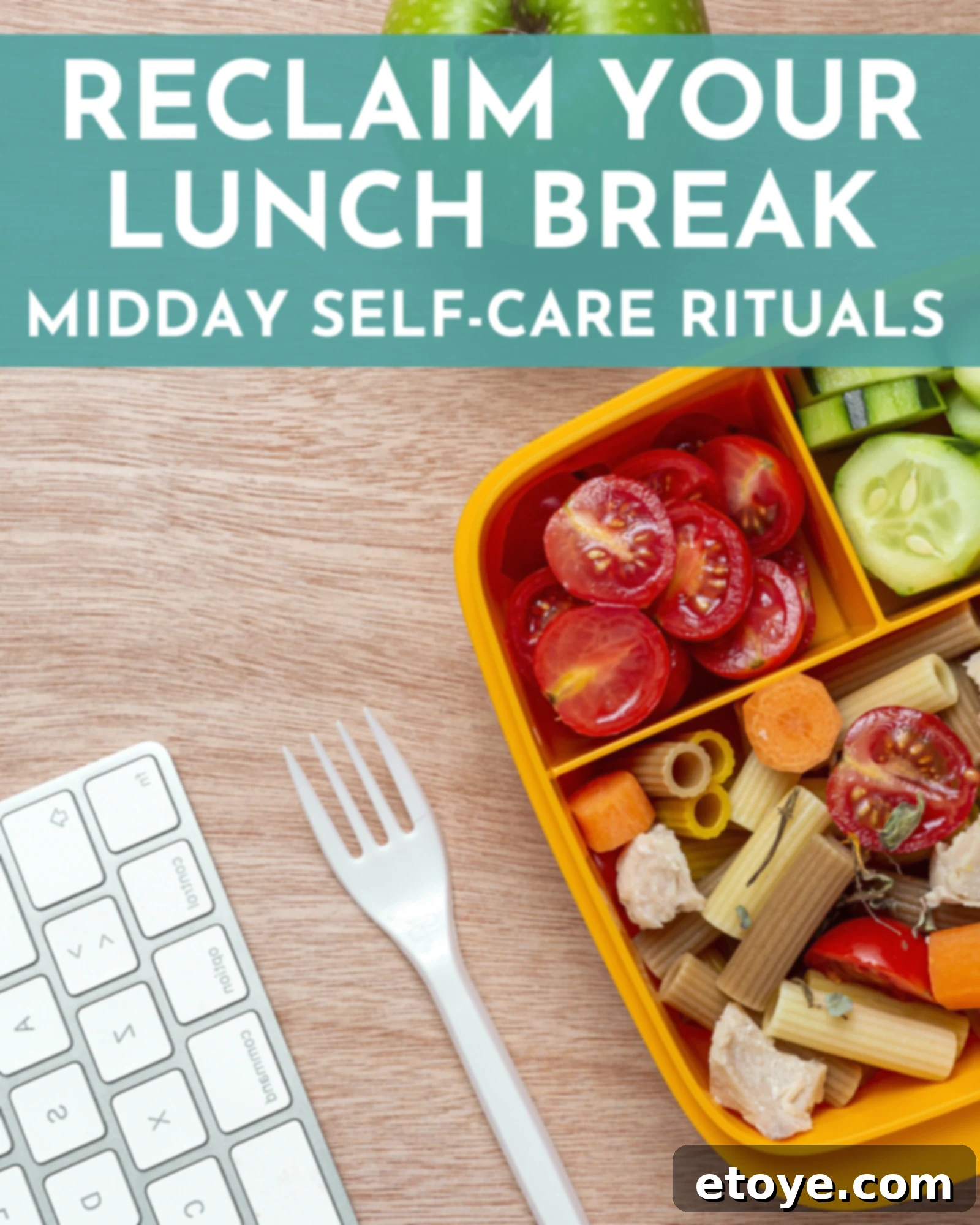In the whirlwind of modern professional life, the concept of a “lunch break” has often been relegated to a hurried bite at the desk, eyes glued to a screen, or a quick scroll through social media feeds. This prevalent habit, unfortunately, transforms what should be a vital period of rejuvenation into another segment of our workday, often leaving us feeling more drained than refreshed. It’s time to challenge this norm and rediscover the profound power of your midday respite. Your lunch hour isn’t just a pause from work; it’s a golden opportunity – a prime piece of real estate in your daily routine – to integrate meaningful self-care rituals that can dramatically enhance your mental clarity, physical well-being, and overall productivity for the remainder of your day, and indeed, your life.
For too long, we’ve treated lunch breaks as an afterthought, a quick interlude before diving back into the grind. But imagine a different scenario: a mindful pause, a deliberate step away from your tasks, where you prioritize your well-being. This isn’t a luxury; it’s a necessity in an increasingly demanding world. By consciously reclaiming and structuring your lunch break, you’re not just taking a moment for yourself; you’re making a strategic investment in your health, happiness, and professional effectiveness. Let’s embark on a journey to transform your midday meal into a mini-retreat, setting the foundation for a more balanced and fulfilling life.

Why Reclaiming Your Lunch Break is Absolutely Essential for Well-being
Can we all agree that incorporating more self-care into our daily lives is unequivocally a good thing? Even a few dedicated minutes can yield significant improvements in our mental health, physical vitality, and overall productivity. When we treat our lunch break as sacred, we unlock a cascade of benefits that extend far beyond the immediate moment. It’s about shifting from merely surviving the workday to genuinely thriving within it.
The Transformative Benefits of Prioritizing Your Midday Recharge
- Significantly Boosts Mental Clarity and Cognitive Function: Taking a conscious step back from your tasks allows your brain to reset and re-energize. When you intentionally disengage from work—even for just 30 to 60 minutes—you’re offering your attention span a much-needed reprieve. This mental downtime helps to clear the fog, reduce decision fatigue, and enhance your ability to focus. As a direct result, you return to your work sharper, more concentrated, and better equipped to tackle complex tasks and challenges with renewed vigor and efficiency. This isn’t lost time; it’s an investment in your cognitive performance.
- Improves Physical and Emotional Health: Engaging in present-moment rituals during your break, such as mindful movement or a short meditation, can profoundly impact your physiological and psychological state. These practices are proven to reduce stress hormones, lower blood pressure, and significantly boost your energy levels. Simple actions like taking a brisk walk outdoors or enjoying a nutritious, balanced meal can help you sidestep the infamous 3 PM energy slump, preventing that desperate struggle to keep your eyes open. Consistent midday self-care acts as a powerful preventative measure against chronic stress and its associated physical ailments.
- Cultivates and Sustains Longer-Term Healthy Habits: Making personal wellness a regular, non-negotiable part of your workday lays a strong foundation for healthier lifestyle choices over time. By dedicating a segment of your day to self-care, you reinforce the importance of your well-being, fostering a mindset where health is a priority, not an afterthought. Consider it a daily mini-investment in your emotional and physical health that continues to pay dividends long after your workday concludes, building resilience and promoting overall longevity.
- Fosters a Positive Mental State and Emotional Resilience: It’s crucial to stop viewing self-care during your lunch break as a mere luxury and instead recognize it as a fundamental necessity for your mental well-being. Tending to your inner state is one of the most critical actions you can take to maintain emotional balance. A brief pause to breathe deeply, engage in gentle stretching, or reflect quietly can profoundly shift your mood, preventing the accumulation of stress and anxiety that often feels like an ever-growing to-do list. It empowers you to approach the rest of your day with greater optimism and calm.
The Hidden Costs and Downsides of Neglecting Your Midday Recharge
Continuously pushing through a demanding workday without providing your brain with a meaningful break—and let’s be clear, mindlessly consuming social media doesn’t count as a break—is a guaranteed recipe for burnout. Here’s a deeper look at the detrimental consequences when you consistently forgo this crucial self-care window:
- Escalating Stress Levels and Increased Risk of Burnout: Denying yourself a proper break keeps cortisol, your body’s primary stress hormone, on constant overdrive. This sustained elevation can lead to chronic stress, characterized by persistent feelings of overwhelm, anxiety, and an inability to relax even outside of work hours. Over time, this state culminates in burnout, a severe condition marked by emotional, physical, and mental exhaustion that significantly impairs your ability to function.
- Plummeting Productivity and Diminished Efficiency: While working through lunch might initially seem like the fastest route to accomplishing more, it is, in fact, a direct path to mental exhaustion and decreased output. Without a deliberate midday reset, your focus, concentration, and overall efficiency inevitably take a sharp nosedive. The quality of your work deteriorates, errors become more frequent, and tasks that once seemed straightforward become challenging, which is the complete opposite of your intended goal.
- Compromised Physical Health in Tangible Ways: Prolonged periods of sedentary behavior combined with chronic stress can manifest in a myriad of physical ailments. This includes persistent back and neck pain, digestive issues, headaches, and a weakened immune system. Furthermore, skipping healthy snacks or nutrient-rich meals in an attempt to “save time” often leads to feelings of sluggishness, irritability, and poor nutritional intake, exacerbating physical discomfort and negatively impacting your mood and interactions with colleagues.
- Heightened Emotional Strain and Reduced Resilience: When you rarely slow down and allow your mind to rest, irritability, mood swings, and even feelings of sadness can subtly creep into your emotional landscape. Research indicates a strong link between distracted eating—a common practice during hurried lunch breaks—and increased anxiety, overeating, and weight gain. Neglecting these vital self-care rituals makes it considerably harder to bounce back from life’s inevitable minor annoyances, leaving you feeling emotionally fragile and less resilient to daily stressors.
Therefore, reclaiming your lunch break isn’t just about catching your breath; it’s the fundamental distinction between merely enduring your day and truly flourishing within it. If you’re unsure where to begin this transformative journey, here are some actionable ideas.

5 Creative Ways to Transform Your Midday Meal Into a Mini-Retreat
Your lunch break offers a unique opportunity to infuse some much-needed calm and personal attention into the middle of your workday. These five strategies are designed to help you step away, recharge, and return to your tasks feeling revitalized and focused.
Mindful Eating & Aromatherapy: A Sensory Experience
The crucial first step is to completely abandon desk dining. Eating while staring at your to-do list or scrolling through emails is not conducive to well-being or digestion. Instead, procure a healthy, nourishing meal and commit to eating it mindfully. Focus intently on the rich flavors, the unique textures, and the sensation of how well it fuels your body. Engage all your senses in the act of eating.
You can elevate this present-moment experience by incorporating the power of essential oils. A few drops of calming lavender in a small, portable diffuser, or a refreshing spritz of citrus (like orange or lemon) on your wrists, can profoundly shift your mental state. This acts like a soothing bath for your brain, offering immediate relaxation without the need for water. As an added benefit, studies suggest that certain essential oils can even contribute to lowering blood pressure, enhancing the overall calming effect of your mindful meal.
Journaling & Curated Soundscapes: Unloading Your Mind
It’s time to normalize the practice of jotting down thoughts, much like a high school student pouring their heart into a spiral notebook. Journaling is an incredibly effective tool for mental decluttering. Whether you choose to unload pressing concerns, reflect on moments of gratitude, or simply engage in free-form writing, this ritual provides a clear pathway to enhanced mental clarity and emotional processing.
For an even more immersive and beneficial experience, pair your journaling session with your favorite calming tunes. Whether it’s the tranquil hum of lo-fi beats, the energetic anthems of Taylor Swift’s “1989,” or classical masterpieces, the right music can serve as a powerful emotional support system, helping you slow down, connect with your feelings, and find a deeper sense of peace during your break.
Embrace the Outdoors: Fresh Air & Vitamin D Boost
If you haven’t ventured into a green space today, take this as your immediate call to action. A brief walk in the middle of your day can work wonders for your mental health, as fresh air acts as a natural medicine for the soul. The benefits of connecting with nature, even briefly, are immense.
Whether you’re working remotely from home or navigating a bustling full-time office environment, make a conscious effort to carve out at least 10-15 minutes. Take a leisurely stroll around the block, or if feasible, seek out a nearby park or garden. This is one of the simplest yet most potent self-care practices available. It will not only help to reset your mental state, improve your attention span, and reduce eye strain but also provide a much-needed dose of natural vitamin D, crucial for mood regulation and bone health.
Power Naps & Guided Meditations: The Ultimate Recharge
Feeling that inevitable mid-afternoon crash approaching? A short, restorative power nap of just 15-20 minutes can dramatically revitalize your energy levels and significantly improve your emotional resilience. You don’t need elaborate equipment—just a comfortable spot, which could be an unused conference room, your car, or even a quiet corner of your workspace. To ease into relaxation and maximize the benefits, consider using a guided meditation app. You’ll awaken feeling refreshed, thoroughly recharged, and perfectly poised to tackle whatever the remainder of the afternoon brings your way with renewed vigor.
Gentle Stretching & Soothing Tea: Releasing Tension
While this might evoke memories of your high school gym coach, listen carefully when we say it’s time to stretch! Incorporating simple stretching exercises into your lunch break, such as gentle neck rolls, shoulder shrugs, or reaching for your toes, can work wonders. These movements help to loosen tight muscles, increase blood circulation, provide an instant boost to your energy levels, and even enhance your mental clarity, counteracting the effects of prolonged sitting.
Follow your stretching routine with a steaming, comforting cup of tea. This seemingly small action goes a long way in soothing your soul and supporting your emotional well-being. Certain herbal teas, depending on your choice (e.g., chamomile for calm, peppermint for alertness), can offer additional targeted benefits. Moreover, it provides a perfect excuse to pause, sip slowly, and savor something warm and comforting, grounding you in the present moment.

Overcoming Resistance: Conquering Common Lunch Break Obstacles
It’s understandable. Prioritizing personal wellness in the midst of a demanding workday can often feel counterintuitive, almost like an indulgence you can’t afford. Between an endless stream of meetings, overflowing inboxes, and the underlying guilt of stepping away, it’s all too easy to relegate your “you-time” to the very bottom of your to-do list. However, it’s crucial to grasp this truth: skipping your break doesn’t make you a hero. It merely makes you a (likely cranky or burnt-out) human. Let’s confront some of the most pervasive excuses people use for neglecting their midday downtime head-on.
The “Too Busy” Trap: Making Time for Wellness
Ah, the quintessential excuse. But here’s the often-overlooked reality: dedicating just 15-30 minutes to truly breathe, stretch, or mindfully enjoy a healthy meal without distractions can paradoxically make you significantly more productive and focused for the entire remainder of your workday. It’s not lost time; it’s an investment in sustainable output.
Try these actionable strategies:
- Start Small: Don’t feel pressured to overhaul your entire routine at once. The easiest and most sustainable way to begin is by taking a very short, intentional break. This could be a five-minute walk around the office, stepping outside for some fresh air, or simply closing your eyes and taking a few deep, mindful breaths at your desk. Incremental changes lead to lasting habits.
- Block Your Calendar: Treat your lunch break with the same reverence and commitment you would any other critical meeting. Actively block out this time in your digital calendar, marking it as “unavailable” or “personal wellness.” By making it a non-negotiable and untouchable appointment, you create a tangible boundary that protects your invaluable self-care time.
Silencing the “Guilt” Monster: Prioritizing Self-Care
Guilt is that insidious little monster that constantly whispers, “You should be working.” It’s a powerful internal barrier. However, the stark reality is that consistently skipping breaks leads directly to increased burnout, diminished productivity, and a pervasive negative mental state. Remember, you cannot pour from an empty cup—so take the time to replenish yours!
Reframe your perspective with these thoughts:
- View Breaks as Essential Fuel: Shift your mindset to perceive breaks not as an interruption, but as vital fuel for peak performance throughout the afternoon. Numerous studies consistently demonstrate that a rested, refreshed brain is a far more focused, creative, and efficient brain. You’re not slacking; you’re strategizing for success.
- Self-Care is Not Selfish, It’s Strategic: Continuously remind yourself that prioritizing self-care is not a selfish indulgence; it is a fundamental, healthy habit that yields immense benefits for every facet of your life—your work quality, your mood, your physical health, and your relationships. It’s a proactive measure to ensure your long-term well-being and effectiveness.
“I Don’t Know What to Do”: Finding Your Flow
The uncertainty of how to best utilize your lunch break can often lead to defaulting to unproductive habits, such as mindlessly scrolling social media or passively munching at your desk. And, for the record, neither of these activities truly qualifies as self-care or provides genuine rejuvenation.
Get started with these simple steps:
- Experiment with Diverse Wellness Practices: Don’t feel confined to a single approach. Explore a variety of personal wellness activities to discover what truly resonates with you and provides the most benefit. Try gentle stretching, reflective journaling, listening to a short podcast, or simply enjoying the invigorating fresh air in a nearby green space. The key is to find what genuinely recharges you.
- Cultivate One Favorite Ritual: Once you’ve experimented, identify one specific self-care ritual that you particularly enjoy and find most beneficial. This could be savoring a warm cup of herbal tea, engaging in simple bodyweight exercises, or practicing a short gratitude meditation. Make this chosen activity a regular, comforting practice that you look forward to each day.
Battling Distractions: Setting Clear Boundaries
The pervasive presence of electronic devices, the constant availability of coworkers, and the nagging mental weight of your burgeoning to-do list can make it incredibly challenging to focus inward and dedicate attention to yourself during your break.
Establish robust boundaries using these methods:
- Implement Digital Detox Protocols: Put your smartphone on “Do Not Disturb” mode, or better yet, physically leave it in a different room or drawer. This creates a necessary separation from incoming notifications and the temptation to check emails or social media, allowing you to fully immerse yourself in your chosen self-care activity.
- Create a Sacred Space: If you’re working in an office environment, consider hanging a polite “Do Not Disturb – On Break” sign on your cubicle or office door. Alternatively, retreat to a designated quiet spot, like a break room, a nearby park bench, or even your car, to ensure uninterrupted personal time. Clearly communicate your need for undisturbed time to colleagues if necessary.
By consciously identifying, acknowledging, and proactively addressing these common barriers, you not only effectively reclaim your precious lunch hour but also actively honor yourself and your vital need for rest and rejuvenation in the process.

Integrating Self-Care into Your Daily Routine: Lasting Habits
The most effective way to ensure your new self-care routine becomes a consistent and deeply ingrained habit is to keep it simple, accessible, and regular. You don’t necessarily require an extended lunch break or a significant amount of extra time; what’s truly essential is a blend of clear intention, a touch of creativity, and unwavering commitment. The daily grind will inevitably persist, but these small, intentional moments of self-care are precisely what will sustain your energy, motivation, and overall well-being in the long run.
To solidify these practices, consider integrating them with existing routines. Perhaps you always make tea after lunch; now, that’s your cue to stretch. Or maybe you always take a short walk; now, make it a mindful walk without your phone. Consistency trumps intensity. Even a 10-minute mindful break is more beneficial than an hour-long, guilt-ridden, distracted one. Be patient with yourself, celebrate small victories, and remember that every conscious choice to prioritize your well-being is a step towards a more balanced, productive, and ultimately happier you.
Do you already have a cherished self-care ritual that you pair with your lunch break? Is there a new idea from this article that you’re excited to try soon and integrate into your workday? We’d love to hear your thoughts and experiences in the comments below!
